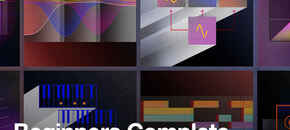- sale
Beginner’s Guide to Audio Effects
Video Courses by ProducertechAlso available in a bundle
With such a wide range of audio effects on offer when producing, it can seem like a monumental task as a beginner to figure out what they all do! This course aims to make that task infinitely simpler by guiding you through all of the most popular effects, broken down into the main categories and with a plethora of examples to help with both understanding and putting them into practice.
The course begins by explaining what an insert effect is and the concept of serial processing, before going into some of the main reasons for applying effects, including changing the timbre of a sound, making its level more consistent and placing it into a virtual space to add extra dimensions to the mix.
After these initial principles have been fully outlined, the tutorials then step through the main effects in more detail, starting with the most common insert effects, EQ and compressor, whilst also looking at other popular effects in the same categories, such as filter and gate. The next module then focuses on two of the most popular effects for adding extra sound into the mix, reverb and delay, explaining in detail what they do to a signal and the various ways of using them to process sounds.
Following on from this, there is a comprehensive look at stereo processing, to help with understanding what it means for a signal to be stereo and to have properties like width, as well as how to create and control that property. With that knowledge, it becomes substantially easier to comprehend how reverb and delay affect stereo content and what some of the more complex modulation effects like chorus, flanger and phaser do.
The last module then moves on to the final category of distortion effects, guiding through amp and pedal devices, before continuing to explore overdrive and saturator. There are demonstrations of the range of processing these effects can provide, from raucous and transformative to much subtler but still hugely significant.
By the end of the course, you’ll have a much improved knowledge of why, when and how to use a wide range of different effects in music production. So enrol now to get instant access to nearly 4 hours of streamed tutorials, along with software projects and a helpful pdf guide, to get your production learning journey off the ground and start confidently using audio effects today!
Sample Module
Course Breakdown
Module 0 - Intro to the Course and Audio Effects
Rob introduces the course and main subjects that will be covered in the subsequent modules.
Module 1 - Using Insert Effects
The first module explains what an insert effect is, and how it differs from standard parallel processing such as send effects, then moves on to a demonstration of some of the main reasons for processing sounds with several of the most popular insert effects.
Lesson 1 - What is an Insert Effect?
Lesson 2 - Insert Effects Examples
Module 2 - Audio Effect Types Part 1 - Frequency and Level Control
This module is the first in a series of modules that work through each of the main effects categories and the most popular effects in each one, with numerous audio examples, visual aids, detailed instruction and lots more. This first series of lessons deals with several of the most important effects, namely EQ and Compressor, as they get control over the frequency content and dynamics of a signal.
Lesson 1 - EQ & Filtering
Lesson 2 - Dynamics Effects Part 1 (Compressor/Limiter)
Lesson 3 - Dynamics Effects Part 2 (Gate)
Module 3 - Audio Effect Types Part 2 - Adding Echoes and Reflections
The next 2 effects under the microscope are reverb and delay, both capable of extending a signal by adding trails of sound such as clouds of reflections or more distinct echoes. These can be fully customised in terms of amount and duration. The separate lessons on each effect include detailed explanations and numerous audio demonstrations of their specific function.
Lesson 1 - Reverb
Lesson 2 - Delay
Module 4 - Stereo Width and Movement
This module is dedicated to all things stereo, beginning with a lengthy explanation of what the word means and how it differs from mono, as well as how stereo width can be identified, created and controlled. The second lesson then walks through and compares some popular effects that all impart stereo information, which include Auto-pan and the remaining modulation effects, namely Chorus, Flanger and Phaser.
Lesson 1 - What is stereo width?
Lesson 2 - Modulation Effects (Auto-pan/Chorus/Flanger/Phaser)
Module 5 - Audio Effect Types 3 - Distortion
The final module focuses on distortion, a category of effect that is commonly known in guitar music, used to turn clean guitars into the massive power instruments from Rock and Metal genres, but is also very much prevalent in Electronic music. The implementation of Amp, Pedal, Overdrive and Saturator are all discussed and shown.
Lesson 1 - Distortion
Lesson 2 - Outro
System Requirements
- An internet connection is required to stream the modules in this course.
Please Note: The modules included in this online guide can be streamed within the Courses section of your account area and are not available to download.
Any references to any brands on this site/page, including reference to brands and instruments, are provided for description purposes only. For example references to instrument brands are provided to describe the sound of the instrument and/or the instrument used in the sample. Plugin Boutique do not have (nor do they claim) any association with or endorsement by these brands. Any goodwill attached to those brands rest with the brand owner. Plugin Boutique or its Suppliers do not accept any liability in relation to the content of the product or the accuracy of the description. "RHODES" is a registered trademark of Joseph A Brandstetter.
Also available in this bundle
- hot!
- sale
- bundle
